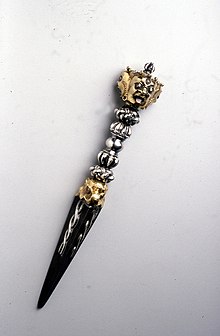
Back ཕུར་པ། Tibetan Phurba Czech Phurba German Phurbu French Փհուրբա Armenian Kila (Buddhisme) ID Phurba Italian ფურბა Georgian Phurba Lithuanian Phurba Polish
This article includes a list of general references, but it lacks sufficient corresponding inline citations. (June 2021) |

| Part of a series on |
| Vajrayana Buddhism |
|---|
 |
The phurba (Tibetan: ཕུར་པ or ཕུར་བ, Wylie: phur pa or phur ba; alternate transliterations: phurpa, phurbu, purbha, or phurpu)[needs IPA] or kīla (Sanskrit Devanagari: कील; IAST: kīla) is a three-sided peg, stake, knife, or nail-like ritual implement deeply rooted in Indo-Tibetan Buddhism and Bön traditions. Its primary association is with the meditational deity Vajrakīlaya (Dorje Phurba), embodying the essence of transformative power. The etymology and historical context of the term reveal some debate. Both the Sanskrit word "kīla" and the Tibetan "phurba" are used interchangeably in sources.
The construction of the phurba is diverse, featuring a pommel, handle, and a blade with three triangular facets. The composition often revolves around the numerological significance of three and nine, with materials ranging from wood and metal to bone and crystal. Phurba blades can be made from meteoric iron, which holds symbolic importance. The pommel typically displays faces of Vajrakīlaya or other sacred motifs. This implement is not intended as a physical weapon, but rather as a spiritual tool, embodying stability and energetic continuity.
The phurba's ritual usage is extensive and encompasses various practices. It is used to establish stability during ceremonies and symbolizes powerful attributes of Vajrayana deities. The phurba's energy is fierce and transfixing, used for purposes such as exorcism, weather manipulation, meditation, and blessings. The implement's connection with Vajrakilaya represents the transmutation of negative energies.
In diverse cultural contexts, the phurba maintains its significance. It remains in use among shamans, magicians, tantrikas, and lamas of various ethnic backgrounds. Different traditions and lineages emphasize various aspects of the phurba, using it for healing, meditation, and connecting with spiritual energies. Ultimately, the phurba stands as a potent emblem of transformation, symbolic power, and the interconnectedness of the spiritual and material realms.